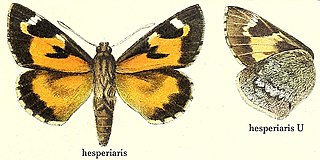 W
WAegiale hesperiaris is a butterfly commonly known as the tequila giant skipper. It is monotypic in the genus Aegiale. Its caterpillar is one of two varieties of edible "maguey worms" that infest maguey and Agave tequilana plants.
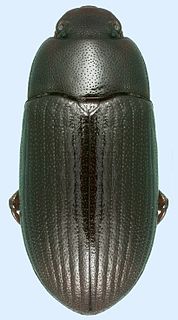 W
WAlphitobius diaperinus is a species of beetle in the family Tenebrionidae, the darkling beetles. It is known commonly as the lesser mealworm and the litter beetle. It has a cosmopolitan distribution, occurring nearly worldwide. It is known widely as a pest insect of stored food grain products such as flour, and of poultry-rearing facilities. It is a vector of many kinds of animal pathogens.
 W
WAtta laevigata is one of about a dozen species of leafcutter ants in the genus Atta, found from Venezuela and south to Paraguay. This species is one of the largest leafcutter species, and can be recognized by the smooth and shining head of the largest workers in a colony. Atta laevigata is known in northern South America as hormiga culona, or as sikisapa in Peru, zompopo de mayo in Central America, bachaco culón in Venezuela, akango in Paraguay, and chicatana in Mexico.
 W
WAtta mexicana is a species of leaf-cutter ant, a New World ant of the subfamily Myrmicinae of the genus Atta. This species is from one of the two genera of advanced attines within the tribe Attini.
 W
WBelostomatidae is a family of freshwater hemipteran insects known as giant water bugs or colloquially as toe-biters, Indian toe-biters, electric-light bugs, alligator ticks, or alligator fleas. They are the largest insects in the order Hemiptera. There are about 170 species found in freshwater habitats worldwide, with more than 110 in the Neotropics, more than 20 in Africa, almost as many in the Nearctic, and far fewer elsewhere. These predators are typically encountered in freshwater ponds, marshes and slow-flowing streams. Most species are at least 2 cm (0.8 in) long, although smaller species, down to 0.9 cm (0.35 in), also exist. The largest are members of the genus Lethocerus, which can exceed 12 cm (4.5 in) and nearly reach the length of some of the largest beetles in the world. Giant water bugs are a popular food in parts of Asia.
 W
WThe bogong moth is a temperate species of night-flying moth, notable for its biannual long-distance seasonal migrations towards and from the Australian Alps, similar to the diurnal monarch butterfly. During the autumn and winter it is found in southern Queensland, western New South Wales, western Victoria, and also in South and Western Australia. Adult bogong moths breed and larvae hatch during this period, consuming winter pasture plants during their growth. During the spring, the moths migrate south or east and reside in mountains such as Mount Bogong, where they gregariously aestivate over the summer until their return towards breeding grounds again in the autumn.
 W
WBombyx mori, the domestic silk moth, is an insect from the moth family Bombycidae. It is the closest relative of Bombyx mandarina, the wild silk moth. The silkworm is the larva or caterpillar of a silk moth. It is an economically important insect, being a primary producer of silk. A silkworm's preferred food are white mulberry leaves, though they may eat other mulberry species and even the osage orange. Domestic silk moths are entirely dependent on humans for reproduction, as a result of millennia of selective breeding. Wild silk moths are not as commercially viable in the production of silk.
 W
WThe cicadas are a superfamily, the Cicadoidea, of insects in the order Hemiptera. They are in the suborder Auchenorrhyncha, along with smaller jumping bugs such as leafhoppers and froghoppers. The superfamily is divided into two families, Tettigarctidae, with two species in Australia, and Cicadidae, with more than 3,000 species described from around the world; many species remain undescribed.
 W
WCybister explanatus is a species of beetle in the family Dytiscidae.
 W
WCyclocephala borealis, the northern masked chafer, is a beetle in the family Scarabaeidae. It is native to North America, where it is considered a crop pest.
 W
WGonimbrasia belina is a species of emperor moth which is native to the warmer parts of southern Africa. Its large edible caterpillar, known as the madora or mopane worm or amacimbi, masontja, feeds primarily but not exclusively on mopane tree leaves. Mopane worms are an important source of protein for many in the region. The species was first described by John O. Westwood in 1849.
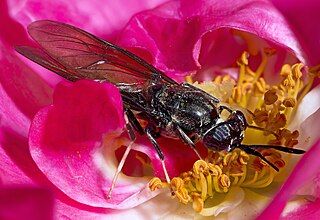 W
WHermetia illucens, the black soldier fly, is a common and widespread fly of the family Stratiomyidae.
 W
WHoney ants, also called honeypot ants, are ants which have specialised workers that are gorged with food to the point that their abdomens swell enormously. Other ants then extract nourishment from them, through the process of trophallaxis. They function as living larders. Honeypot ants belong to any of several genera, including Myrmecocystus and Camponotus. They were first documented in 1881 by Henry C. McCook, and described further in 1908 by William Morton Wheeler.
 W
WAcheta domesticus, commonly called the house cricket, is a cricket most likely native to Southwestern Asia, but between 1950 and 2000 it became the standard feeder insect for the pet and research industries and spread worldwide. They can be kept as pets themselves, as this has been the case in China and Japan.
 W
WThe huhu beetle is a longhorn beetle endemic to New Zealand. It is the heaviest beetle found in New Zealand.
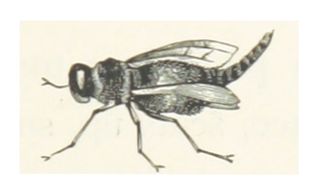 W
WHypoderma tarandi, also known as the reindeer warble fly and reindeer botfly, is a species of warble fly that is parasitic on reindeer.
 W
WLethocerus indicus is a giant water bug in the family Belostomatidae, native to South and Southeast Asia, as well as southeast China the Ryukyu Islands and New Guinea. It was originally described as Belostoma indicum but is no longer placed in that genus.
 W
WLiometopum apiculatum is a species of ant in the subfamily Dolichoderinae. Liometopum apiculatum ants are found in arid and semi-arid regions of southwestern United States and Mexico to Quintana Roo.
 W
WLiometopum occidentale is a species of ant in the subfamily Dolichoderinae. Liometopum occidentale is often mistaken for carpenter ants by homeowners and pest management professionals. This mistaken identity is due to morphological and behavioral characteristics they share with carpenter ants; namely polymorphic workers, a smooth convex thoracic profile, and the tendency to excavate wood. Consequently, their importance as structural pests may be greatly under reported, especially in California, Oregon, and Washington, United States.
 W
WLocusts are a collection of certain species of short-horned grasshoppers in the family Acrididae that have a swarming phase. These insects are usually solitary, but under certain circumstances they become more abundant and change their behaviour and habits, becoming gregarious. No taxonomic distinction is made between locust and grasshopper species; the basis for the definition is whether a species forms swarms under intermittently suitable conditions.
 W
WMaguey worms, are one of two species of edible caterpillars that infest maguey and Agave tequilana plants.
 W
WMealworms are the larval form of the mealworm beetle, Tenebrio molitor, a species of darkling beetle. Like all holometabolic insects, they go through four life stages: egg, larva, pupa, and adult. Larvae typically measure about 2.5 cm or more, whereas adults are generally between 1.25 and 1.8 cm in length.
 W
WThe migratory locust is the most widespread locust species, and the only species in the genus Locusta. It occurs throughout Africa, Asia, Australia and New Zealand. It used to be common in Europe but has now become rare there. Because of the vast geographic area it occupies, which comprises many different ecological zones, numerous subspecies have been described. However, not all experts agree on the validity of some of these subspecies.
 W
WMole crickets are members of the insect family Gryllotalpidae, in the order Orthoptera. Mole crickets are cylindrical-bodied insects about 3–5 cm (1.2–2.0 in) long as adults, with small eyes and shovel-like fore limbs highly developed for burrowing. They are present in many parts of the world and where they have arrived in new regions, may become agricultural pests.
 W
WMyrmecocystus is a North American genus of ants in the subfamily Formicinae. It is one of five genera that includes honeypot ants. Worker ants keep and tend plerergates, which are other ants that store large quantities of nutritious fluid in their abdomens to feed the colony during famine times.. Some species engage in highly territorial tournaments, which can result in intraspecific slavery. During the raids, they carry off larvae, workers, and plerergates.
 W
WNsenene is the Luganda name for Ruspolia differens: a bush cricket in the tribe Copiphorini of the 'cone-head' subfamily.
 W
WOrthoptera is an order of insects that comprises the grasshoppers, locusts and crickets, including closely related insects such as the katydids and wētā. The order is subdivided into two suborders: Caelifera – grasshoppers, locusts and close relatives; and Ensifera – crickets and close relatives.
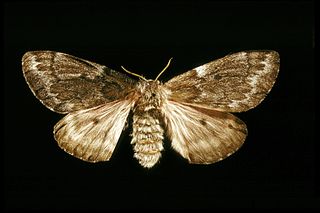 W
WThe Pandora moth or Pandora pinemoth is an insect belonging to the moth genus Coloradia. The species was first described by C. A. Blake in 1863. It is native to the western United States. The larvae of the Pandora moth feed on the foliage of several species of pine trees, including the lodgepole, Jeffrey, and ponderosa pines. The larvae populations sometimes reach high enough levels to cause severe defoliation; such outbreaks have occurred in northern Arizona, central Oregon, and southern California. The Paiute people in California's Owens Valley and Mono Lake areas harvest, prepare, and store the larvae as a preferred food. This has brought the natives into conflict with the United States Forest Service, which has sought to control moth populations through the use of insecticides.
 W
WMagicicada is the genus of the 13-year and 17-year periodical cicadas of eastern North America, consisting of seven species. Although they are sometimes called "locusts", this is a misnomer, as cicadas belong to the taxonomic order Hemiptera, suborder Auchenorrhyncha, while locusts are grasshoppers belonging to the order Orthoptera. Magicicada belongs to the cicada tribe Lamotialnini, a group of genera with representatives in Australia, Africa, and Asia, as well as the Americas.
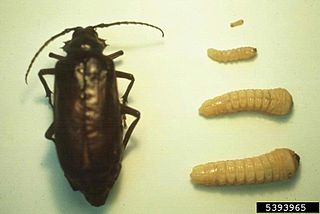 W
WPrionus californicus, commonly known as the California root borer, is a species of insect in the longhorn beetle family (Cerambycidae). It is native to the American west where it is often a pest of orchard and vine crops.
 W
WRuspolia nitidula is a species belonging to the subfamily Conocephalinae of the family Tettigoniidae. It is found throughout Europe, Africa, and the Palearctic part of Asia. A vernacular name that has been used is "cone-headed grasshopper", although it is not a grasshopper, but rather a bush cricket.
 W
WThe sisal weevil or agave weevil is a species of polyphaga beetle of the family of the Curculionidae.
 W
WSphenarium purpurascens, is a grasshopper species in the genus Sphenarium found in Mexico and Guatemala.
 W
WSternocera aequisignata is a species of beetles belonging to the Buprestidae family. Its bright metallic green elytra are frequently used jewellery making.
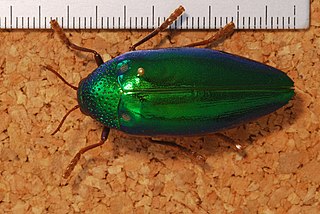 W
WSternocera ruficornis is a species of beetle belonging to the Buprestidae family. Its bright metallic green elytra are frequently used in jewellery making.
 W
WTessaratomidae is a family of true bugs. It contains about 240 species of large bugs divided into 3 subfamilies and 56 genera.
 W
WVespula flaviceps is a species of social wasp in the genus Vespula. It found in Eastern Asia and Japan. Studies have suggested that the queens of this species may mate with more males and use sperm more evenly. The reason for this is not yet well understood.
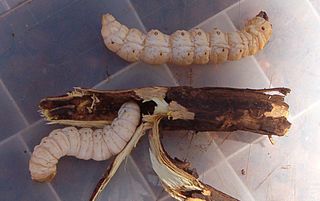 W
WThe witchetty grub is a term used in Australia for the large, white, wood-eating larvae of several moths. In particular, it applies to the larvae of the cossid moth Endoxyla leucomochla, which feeds on the roots of the witchetty bush that is widespread throughout the Northern Territory and also typically found in parts of Western Australia and South Australia, although it is also found elsewhere throughout Australia.
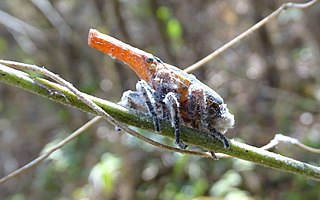 W
WZanna madagascariensis, the Malagasy lantern bug, is endemic to Madagascar. It is a member of the Zanninae, considered to be a subfamily of the Fulgoridae. The nymphs are sometimes referred to as lantern-flies because of their large lantern like snout, although this does not emit light. The adult bugs are known as sakandry, and are consumed by the rural people of Madagascar. Roasted whole, they are reported to taste like bacon.